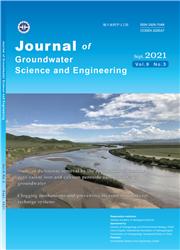某锑矿区地下水重金属含量统计特征及其相互关系
IF 1.8
4区 地球科学
Q3 WATER RESOURCES
引用次数: 2
摘要
近年来,国内外对金属矿山重金属污染的研究大多集中在地表的水、土壤和植物上。金属矿山地下水中重金属污染的研究还比较缺乏。本研究选取了某锑矿区作为典型研究区。同时,对地下水中重金属的统计特征进行了研究。并通过相关分析、聚类分析和主成分分析,初步探讨了二者的相互关系。结果表明:研究区地下水中过量元素为Sb、As、Pb、Se和Ni。其中Sb、As、Pb的平均质量浓度高于饮用水标准(GB5749-2006)。旱季地下水中大部分重金属浓度低于或等于雨季。锌是地下水中唯一表现出不同格局的金属,其浓度在旱季高于雨季。在地层浸出和吸收效应的影响下,地下水中除Pb、Ba外的重金属浓度均低于或等于地表水。As和Se两种重金属具有显著的正相关关系,说明二者可能经历了相似的环境地球化学作用。Zn、Hg、Pb、Mn之间的联系不明显;因此,这些元素的来源有很大的不同。此外,Se和As元素与co32和F -元素有明显的正相关关系。Pb与po43、h2sio3、耗氧量呈显著正相关。聚类分析结果表明,研究区9种不同重金属可分为3类:Zn、Cd、Mn、Hg、Cu、Cr为第一类,Se、As为第二类,Pb为最后一类。主成分分析将6种重金属(Zn、As、Hg、Pb、Mn、Se)划分为4种不同的主成分,可用于评价地下水重金属污染情况。该方法的可靠性大于91%。为建立地下水重度精神污染评价指标体系和探索地下水重度精神污染评价方法提供理论依据和模型。本文章由计算机程序翻译,如有差异,请以英文原文为准。
Statistical characteristics of heavy metals content in groundwater and their interrelationships in a certain antimony mine area
: In recent years, most of domestic and foreign researches about heavy metal pollutions of metal mine mainly focus on water, soil and plants on the surface. There is lack of researches about heavy metal pollution in groundwater of metal mine. In this research, a certain antimony mine area is selected as a typical study area. Also, the study about statistical characteristics of heavy metals in groundwater has been carried out. Furthermore, the interrelationships have been preliminarily discussed through related analysis, such as relevant analysis, cluster analysis and principle component analysis. The results show that: the excessive elements in groundwater of study area are Sb, As, Pb, Se, and Ni. The average mass concentration of Sb, As, and Pb is higher than that of drinking water standards (GB5749-2006). The concentration of most heavy metals in dry season is lower than or equal to that in wet season for groundwater. Zn is the only metal in groundwater showing a different pattern, the concentration of which in dry season is higher than that in wet season. Under the impacts of stratum leaching and absorption effect, the concentration of heavy metals (except Pb and Ba) in groundwater are lower than or equal to that in surface water. As and Se, the two heavy metals have a significant positive correlation, which shows the two elements might have gone through similar environmental geochemical effect. Also, the connection among Zn, Hg, Pb, and Mn is not obvious; therefore, the sources of those elements are quite different. In addition, the elements of Se and As have obvious positive interrelationship with elements of CO 32-and F - . Also, the Pb has significant positive correlation with PO 43, H 2 SiO 3 and oxygen consumption. The results of cluster analysis show that 9 different heavy metals in the study area can be divided into 3 categories: Zn, Cd, Mn, Hg, Cu, and Cr belong to the first category, Se and As belong to the second one, and the last category is Pb. Also, the principle component analysis divides 6 heavy metals (Zn, As, Hg, Pb, Mn, and Se) into 4 different principle components, which can be utilized to assess heavy metals pollution situations in groundwater. The reliability of this method is higher than 91%. Moreover, the research provides theory basis and models for establishing evaluation index system and exploring the evaluation method of heavy mental pollution in groundwater.
求助全文
通过发布文献求助,成功后即可免费获取论文全文。
去求助
来源期刊

Journal of Groundwater Science and Engineering
WATER RESOURCES-
CiteScore
2.80
自引率
9.10%
发文量
308
期刊介绍:
It publishes original, innovative, and integrative research in groundwater science and engineering with a focus on hydrogeology, environmental geology, groundwater resources, agriculture and groundwater, groundwater resources and ecology, groundwater and geologic environment, groundwater circulation, groundwater pollution, groundwater exploitation and utilization, hydrogeological standards and methods, groundwater information science, climate change and groundwater. The Editorial Board is composed of more than sixty world-renowned experts and scholars, 47% of whom are foreign scientists. Up to now, the foreign authors contributed papers are from USA, Japan, Canada, Australia, Russia, Mongolia, Thailand and Vietnam.
 求助内容:
求助内容: 应助结果提醒方式:
应助结果提醒方式:


